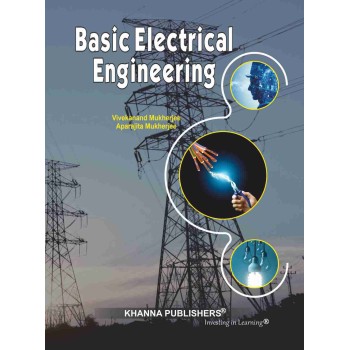Basic Electrical Engineering
- Author Dr. Vivekananda Mukherjee & Dr. Aparajita Mukherjee
- ISBN: 978-93-92549-17-5
- ₹ 729.00
-
₹ 583.20
| Book Detail | |
| About The Author's | V. Mukherjee received his Graduation in Electrical Engineering and Postgraduation in Power Systems from B.E. College, Shibpur, Howrah, India and B.E. College (Deemed University), Shibpur, Howrah, India, respectively. He received his PhD Degree from NIT, Durgapur, India. Presently, he is an Associate Professor in the Department of Electrical Engineering, Indian Institute of Technology (Indian School of Mines), Dhanbad, Jharkhand, India. He has published 170 papers in International Journal of repute and guided 27 research scholars. His research interest is the application of Soft Computing Intelligence to various fields of Power System. Aparajita Mukherjee received her B.Tech. Degree in Electrical Engineering and M. Tech Degree in Power System from West Bengal University of Technology, Kolkata, India. She obtained her PhD Degree from Indian Institute of Technology (Indian School of Mines), Dhanbad, India. Currently, she is an Assistant Professor in the Department of Electrical Engineering, Meghnad Saha Institute of Technology, Kolkata,India. |
| What's special / Useful in this book | Basic Electrical Engineering is a compulsory course at the first-year level for all disciplines of Engineering. It is intended for Electrical, Electronics, Mechanical, Civil, Computer and other disciplines of Engineering. It also covers the syllabus of 'Electrical Science prescribed for the Diploma as well as the A.M.I.E. students. Students preparing for various competitive exams will also be benefitted from this book. This book contains eleven chapters. The first four chapters have been developed on important topics including Electrostatics, Fundamental Laws, Concepts in Electrical Circuits, Network Theorems, Electromagnetism and Magnetic Circuits. Chapters 5 to 9 incorporate the Fundamental Principles of AC Circuits, Three-phase Supply and Electrical Machines. Chapter 10 deals with the basic outline of the Power System containing the Basic Structure of the AC Network System, Different Voltage Levels used in Modern Power Transmission, Classification of Transmission Lines and Comparison of Different Conductor Costs used in Different Transmission Networks. The Electrical Measuring Instruments portion is described in Chapter 11. |
| Publication Year | 2022 |
| ISBN-13 | 978-93-92549-17-5 |
| Edition | 1st |
| Pages | 719 |
| Preface | |
| Preface | This volume has been written to serve as a textbook for first-year Bachelor of Technology students of Electrical Engineering (common to other branches) that covers the contents as per the new syllabus of AICTE w.e.f. 2018-2019 session. This book is written in very simple language so that the students may easily grasp the subject. The rationalized SI of units has been used throughout this book. Systematic presentation, crystal-clear approach, and straightforward and comprehensible arrangement of basic concepts are the main asset of this book. Extensive coverage of Power System Outline, Transformers and DC machines has been made in this book. It is impossible to gain a thorough understanding of electrical principles without working out a large number of numerical problems; and while doing this, students should make a habit of writing the solutions logically. At the end of each chapter, review questions and multiple-choice questions with answers have been included for better practice. It is earnestly hoped that with the extensive revisions, modifications and improvement the present edition will complement the students in preparing for their regular examinations as well as competitive examination. |
| Table of Contents | |
| Table of Contents | 1. ELECTROSTATIC 2. MAGNETIC CIRCUITS 3. DC CIRCUIT FUNDAMENTALS 4. BASIC LAWS AND METHODS OF ANALYSIS 5. AC CIRCUIT 6. THREE PHASE SUPPLY 7. TRANSFORMERS 8. DC MACHINE 9. THREE PHASE INDUCTION MOTOR 10. OUTLINE OF POWER SYSTEM 11. ELECTRICAL MEASURING INSTRUMENTS 12A. ADDITIONAL SUPPLEMENTARY NUMERICAL PROBLEMS 12B. ADDITIONAL SUPPLEMENTARY NUMERICAL PROBLEMS 12C. ADDITIONAL SUPPLEMENTARY NUMERICAL PROBLEMS |

